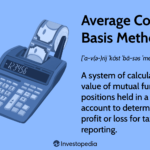What Is the Average Cost Basis Method?
The average cost basis method is a system of calculating the value of mutual fund positions held in a taxable account to determine the profit or loss for tax reporting. Cost basis represents the initial value of a security or mutual fund that an investor owns.
The average cost is then compared with the price at which the fund shares were sold to determine the gains or losses for tax reporting. The average cost basis is one of many methods that the Internal Revenue Service (IRS) allows investors to use to arrive at the cost of their mutual fund holdings.
Understanding the Average Cost Basis Method
The average cost basis method is commonly used by investors for mutual fund tax reporting. A cost basis method is reported with the brokerage firm where the assets are held. The average cost is calculated by dividing the total amount in dollars invested in a mutual fund position by the number of shares owned. For example, an investor that has $10,000 in an investment and owns 500 shares would have an average cost basis of $20 ($10,000 / 500).
Key Takeaways
- The average cost basis method is a way of calculating the value of mutual fund positions to determine the profit or loss for tax reporting.
- Cost basis represents the initial value of a security or mutual fund that an investor owns.
- The average cost is calculated by dividing the total amount in dollars invested in a mutual fund position by the number of shares owned.
Types of Cost Basis Methods
Although many brokerage firms default to the average cost basis method for mutual funds, there are other methods available.
FIFO
The first in, first out (FIFO) method means that when shares are sold, you must sell the first ones that you acquired first when calculating gains and losses. For example, let’s say an investor owned 50 shares and purchased 20 in January while purchasing 30 shares in April. If the investor sold 30 shares, the 20 in January must be used, and the remaining ten shares sold would come from the second lot purchased in April. Since both the January and April purchases would have been executed at different prices, the tax gain or loss would be impacted by the initial purchase prices in each period.
Also, if an investor has had an investment for more than one year, it would be considered a long-term investment. The IRS applies a lower capital gains tax to long-term investments versus short-term investments, which are securities or funds acquired in less than one year. As a result, the FIFO method would result in lower taxes paid if the investor had sold positions that were more than a year old.
LIFO
The last in first out (LIFO) method is when an investor can sell the most recent shares acquired first followed by the previously acquired shares. The LIFO method works best if an investor wants to hold onto the initial shares purchased, which might be at a lower price relative to the current market price.
High-Cost and Low-Cost Methods
The high-cost method allows investors to sell the shares that have the highest initial purchase price. In other words, the shares that were the most expensive to buy get sold first. A high-cost method is designed to provide investors with the lowest capital gains tax owed. For example, an investor might have a large gain from an investment, but doesn’t want to realize that gain yet, but needs money.
Having a higher cost means the difference between the initial price and the market price, when sold, will result in the smallest gain. Investors might also use the high-cost method if they want to take a capital loss, from a tax standpoint, to offset other gains or income.
Conversely, the low-cost method allows investors to sell the lowest-priced shares first. In other words, the cheapest shares you purchased get sold first. The low-cost method might be chosen if an investor wants to realize a capital gain on an investment.
Choosing a Cost-Basis Method
Once a cost basis method has been chosen for a specific mutual fund, it must remain in effect. Brokerage firms will provide investors with appropriate annual tax documentation on mutual fund sales based on their cost basis method elections.
Investors should consult a tax advisor or financial planner if they are uncertain about the cost basis method that will minimize their tax bill for substantial mutual fund holdings in taxable accounts. The average cost basis method may not always be the optimal method from a taxation point of view. Please note that the cost basis only becomes important if the holdings are in a taxable account, and the investor is considering a partial sale of the holdings.
Specific Identification Method
The specific identification method (also known as specific share identification) allows the investor to choose which shares are sold in order to optimize the tax treatment. For example, let’s say an investor purchases 20 shares in January and 20 shares in February. If the investor later sells 10 shares, they can choose to sell 5 shares from the January lot and 5 shares from the February lot.
Example of Cost Basis Comparisons
Cost basis comparisons can be an important consideration. Let’s say that an investor made the following consecutive fund purchases in a taxable account:
- 1,000 shares at $30 for a total of $30,000
- 1,000 shares at $10 for a total of $10,000
- 1,500 shares at $8 for a total of $12,000
The total amount invested equals $52,000, and the average cost basis is calculated by dividing $52,000 by 3,500 shares. The average cost is $14.86 per share.
Suppose the investor then sells 1,000 shares of the fund at $25 per share. The investor would have a capital gain of $10,140 using the average cost basis method. The gain or loss using average cost basis would be as follows:
- ($25 – $14.86) x 1,000 shares = $10,140.
Results can vary depending on the cost-basis method chosen for tax purposes:
- First in first out: ($25 – $30) x 1,000 shares = – $5,000
- Last in first out: ($25 – $8) x 1,000 = $17,000
- High cost: ($25 – $30) x 1,000 shares = – $5,000
- Low cost: ($25 – $8) x 1,000 = $17,000
From strictly a tax standpoint, the investor would be better off selecting the FIFO method or the high-cost method to calculate the cost basis before selling the shares. These methods would result in no tax on the loss. However, with the average cost basis method, the investor must pay a capital gains tax on the $10,140 in earnings.
Of course, if the investor sold the 1,000 shares using the FIFO method, there’s no guarantee that when the remaining shares are sold that $25 will be the selling price. The stock price could decrease, wiping out most of the capital gains and an opportunity to realize a capital gain would have been lost. As a result, investors must weigh the choice as to whether to take the gain today and pay the capital gains taxes or try to reduce their taxes and risk losing any unrealized gains on their remaining investment.



